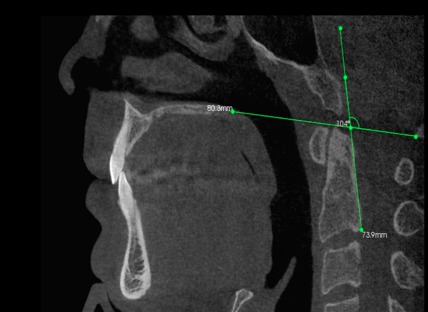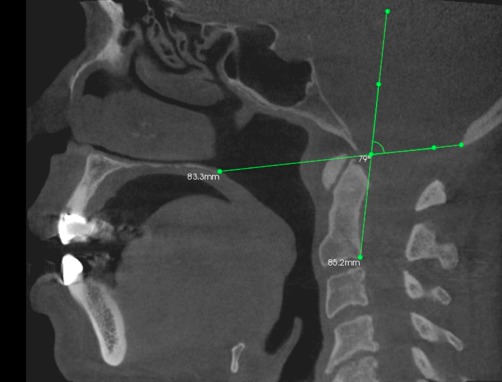IADR Abstract Archives
Diagnosis of Atlantoaxial Subluxation Using Craniocervical Cephalometric Indices and CBCT
Objectives: To identify atlantoaxial subluxation and potential risk for spinal cord injury using craniocervical cephalometric indices in patients who were referred for maxillofacial imaging to a US Dental School.
Methods: One hundred thirty-five patients, who presented to a US Dental School, were randomly selected from a database. The CBCT volumes of these patients were analyzed cephalometrically to obtain pertinent craniocervical measurements used in predicting the risk of atlantoaxial subluxation or spinal cord injury. All measurements were done using mid-sagittal views. CBCT volumes were acquired using a Carestream CS9300 machine (Carestream Dental, Atlanta, GA) and were viewed with the native software, CS 3D Imaging. The vertical atlantioaxial index (VAAI), powers ratio (PR), and posterior odontoid angle (POA) were assessed and recorded for each patient.
VAAI measures the vertical relationship of the atlas and axis. The normal VAAI value is 0.8.
The PR is a ratio that is used to identify the prevalence of Atlanto-occipital dissociation (AOD). The normal ratio is 1:1.
The POA is a new angle proposed in this study and used to identify the degree of posterior displacement of the dens towards foramen magnum space. It is postulated that a POA of <90° will increase the potential for spinal cord compression.
Results: In the selected patients, the VAAI ranged from 0.63 to 0.93. The mean VAAI was 0.748. One hundred and seven patients with a VAAI of less than 0.8 were identified. The mean PR was 0.765. The PR did not exceed one for any of the patients in the study suggesting that no one had AOD. The POA ranged from 79° to 119°. The mean POA was 95°. There were 89 patients who had a POA of ≥90°, and 46 patients had POA of <90°. Therefore, there is a slightly increased potential of risk for the compression of the spinal cord in 46 patients. A correlation statistic was used that showed significance based on comparisons between various CBCT cephalometric craniocervical measurements.
Conclusions: Although the p values varied between the POA and VAAI, Powers and VAAI as well as POA and Powers, they were significant at various levels (<0.001 to <0.1). Based on the results of this study, it was concluded that the VAAI, PR, and POA are useful markers for identifying potential risk for atlantoaxial subluxation.
Methods: One hundred thirty-five patients, who presented to a US Dental School, were randomly selected from a database. The CBCT volumes of these patients were analyzed cephalometrically to obtain pertinent craniocervical measurements used in predicting the risk of atlantoaxial subluxation or spinal cord injury. All measurements were done using mid-sagittal views. CBCT volumes were acquired using a Carestream CS9300 machine (Carestream Dental, Atlanta, GA) and were viewed with the native software, CS 3D Imaging. The vertical atlantioaxial index (VAAI), powers ratio (PR), and posterior odontoid angle (POA) were assessed and recorded for each patient.
VAAI measures the vertical relationship of the atlas and axis. The normal VAAI value is 0.8.
The PR is a ratio that is used to identify the prevalence of Atlanto-occipital dissociation (AOD). The normal ratio is 1:1.
The POA is a new angle proposed in this study and used to identify the degree of posterior displacement of the dens towards foramen magnum space. It is postulated that a POA of <90° will increase the potential for spinal cord compression.
Results: In the selected patients, the VAAI ranged from 0.63 to 0.93. The mean VAAI was 0.748. One hundred and seven patients with a VAAI of less than 0.8 were identified. The mean PR was 0.765. The PR did not exceed one for any of the patients in the study suggesting that no one had AOD. The POA ranged from 79° to 119°. The mean POA was 95°. There were 89 patients who had a POA of ≥90°, and 46 patients had POA of <90°. Therefore, there is a slightly increased potential of risk for the compression of the spinal cord in 46 patients. A correlation statistic was used that showed significance based on comparisons between various CBCT cephalometric craniocervical measurements.
Conclusions: Although the p values varied between the POA and VAAI, Powers and VAAI as well as POA and Powers, they were significant at various levels (<0.001 to <0.1). Based on the results of this study, it was concluded that the VAAI, PR, and POA are useful markers for identifying potential risk for atlantoaxial subluxation.


